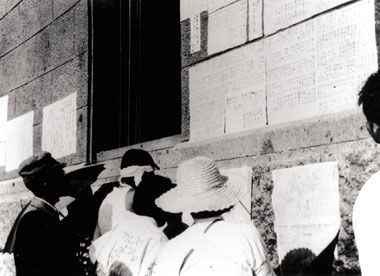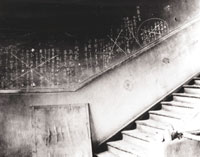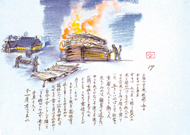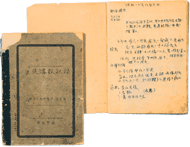 |
| Looking for Children |
| "Is so-and-so here?" Family members and teachers walked the burnt plain looking for missing children. They searched through relief stations crammed with the wounded and the dead. The scenes at usable school buildings were extraordinary-the injured poured in, and an endless stream of dead were carried out to the schoolyard for cremation. Teachers hastily created offices in charred, ravaged schools, then desperately collected information on students to provide to families when they came to inquire. |
 60/People searching for the names of family members on lists at relief stations About August 10, 1945 Sumitomo Bank, Hiroshima Branch (Kamiya-cho) Photo by Yotsugi Kawahara Courtesy of the Association of the Photographers of the Atomic Bomb Destruction of Hiroshima |
 61/Messages written on the schoolhouse wall October 6, 1945 Fukuromachi National School (Fukuro-machi) Photo by Shunkichi Kikuchi Courtesy of Tokuko Kikuchi Messages scrawled on walls of schoolhouses standing in the burnt plain, bereft of paper or pencil, were key means of communication. |
 |
 |
 |
||
| 62/Hibakusha gathering
at the schools Afternoon, August 7, 1945 Second National School (Minami-kan-on) Drawing and text by Yoshitada Mitsuda "An Akatsuki Corps relief station opened in the school soon filled with A-bomb victims. They spilled out of the auditorium and onto the ground outside, where they perished one after another under the hot sun. Night and day they moaned and cried for their parents, for water." |
63/Cremating corpses
in the schoolyard Hesaka National School (Hesaka-izue) Drawing and text by Yoshio Takahara "Mountains of corpses filled the schoolyard at Hesaka Elementary. Yesterday, they cremated 135. Today, another 98.... They stacked up branches, laid the corpses on top, and cremated them. Among them were innocent children! Children! " |
64/War disaster record and Student information of Shudo Junior High School
Courtesy of Shudo Junior and Senior High School This notebook records events from the day of the atomic bombing until the school reopened on September 15. It describes the mass confusion and conditions at the school after the bombing-firefighting, searching for students, coping with a dead student-until the resumption of classes. Shudo Junior High School sent 180 second-year students to help with building demolition near the City Hall. Of these, 136 died. |
| Mobilized Students -The Lost Tomorrows of the Students- Introduction Schools Stained the Color of War The Start of Student Mobilization Building Demolition Amplified the Tragedy The Suffering of Mobilized Students Looking for Children Reopening in the Burnt Ruins Monuments to the Students Return to TOP |